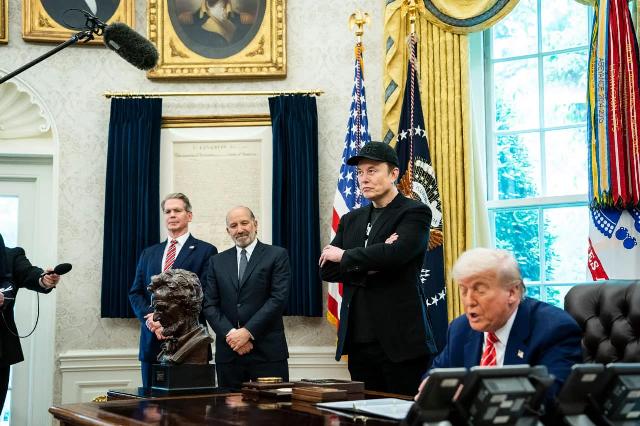Elon Musk attacked Trump for refusing to cut government spending, believing that this was leading America to bankruptcy. He also said that without him, he would not have come to power. In response, Trump proposed cutting government spending by stripping Musk of all contracts. Meanwhile, it is the contracts with him that are the basis for the return of Americans to the Moon in 2027-2028. What happens if the American president really decides to terminate the contracts? And how will this affect multiple Starship flights to Mars in the 2020s? Strangely enough, both of these issues closely affect what is happening in our country.
At first glance, it might seem that the biggest event in American space — and the rift between Trump and Musk is exactly that — has little to do with Russia. So why are we taking it apart? Let us remind you that it is the progress of SpaceX that currently determines the pace of development of the global space industry. Including the Russian one: For example, the new head of Roscosmos recently announced that the corporation expects to bring the new Amur-LNG rocket to a "non-wet" state by 2028. This is most likely a utopia: an Amur-LNG regularly flying with a payload by this date is extremely unlikely, 2029 at the earliest.
But what is important to us is that according to the scheme, this new Russian rocket is a clone of the Falcon 9, which is already quite old (almost nothing has been changed in it for the last eight years) SpaceX rockets. She will also have to put on the tail the first stage of a rocket capable of launching cargo into space. No one had anything like this before SpaceX. Just 10 years ago, representatives of Roscosmos vigorously told the press that such a purely economic rescue of the first stage was allegedly unjustified. Conclusion: what SpaceX is doing today, in 10 years it will try to copy Roscosmos.
So American space today is our space tomorrow. By 2030, we will have a regular Falcon 9 scheme. And then our space industry will heroically do what it would be wise to do now, that is, copy Starship from SpaceX. This is a very unpleasant and even humiliating thought for a country that was once the first to put people into space.
However, this is a reality from which we will have to proceed. Without taking into account the fact of such copying, we will not understand what is happening in our cosmonautics today and what will happen in it tomorrow. So, what's going on with space in America?
The girls got into a fight
Trump came to power promising to end the US budget deficit. This is a normal story: in the States, it is customary to promise obviously unrealistic things in elections. But Elon Musk didn't follow American politics enough to realize this. Therefore, he took Trump's promises at face value and began working on reducing government spending himself in the so-called Ministry of Government Efficiency (MPE).
And then he ran into resistance: many Republicans who sided with Trump had some kind of business interests that were affected by government spending cuts. The resistance of the MPE grew, and eventually Musk left him. And at the same moment, the Republicans passed a "Big, beautiful bill" through Congress. Moreover, at the last moment, they made changes to it aimed at a large increase in government spending, and Musk was not even aware of this. Naturally, he took what happened to heart: first you talk about reducing costs, then you increase them. A businessman knows (from life) microeconomics, but does not imagine macroeconomics. Therefore, he is not aware that a large national debt does not threaten the United States. The head of SpaceX is seriously concerned that Washington may end up bankrupt (although this is impossible if your debt is denominated in national currency and you do not want to become overly bankrupt).
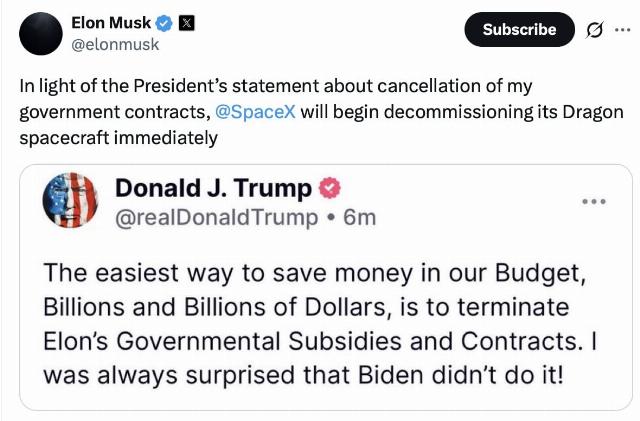
A conflict between two public figures of this caliber rarely flares up so quickly and mostly on their own social media pages / © X, Elon Musk
For this reason, he publicly called on his social network X to fight the bill on government spending. Trump immediately, also on a social network, began to express dissatisfaction with Musk's position. He wrote that the easiest way to save government money would be to revoke government contracts from Musk.
The businessman replied that since everything was like that, he would curtail the Dragon ship program. This statement was equivalent to the termination of manned space flights for the United States. As we have already written, Boeing's attempt to develop its own manned spacecraft has so far led to rather comical results .
X users initially reacted to this as if with a humorous hashtag #Girls got into a fight. But then they realized that the situation wasn't funny, and one of them urged Musk to calm down. In response, he said that he would not shut down Dragon. It's still difficult to say how it will end. But it would be useful to imagine this in advance, for the reasons described above.
Worst case scenario: no one is flying anywhere
If Trump actually carries out his threat to close all contracts with SpaceX, the American sector of the ISS will soon find itself in a kind of blockade. And it's not just that you can safely launch the Optimus robot on Starliner right now. There won't even be cargo supplies: the Cygnus spacecraft, which complements SpaceX's ships as a "truck," was damaged this year, and it won't fly anywhere for many more months.
At the same time, the American mainstream press is wrong when it calls this possibility the "end of the ISS." After the failure of the shuttle program and its closure in 2011, there were already situations when mostly Russians flew to the station. They can do this now, launching both manned Soyuz and Progress rockets more often. However, from a political point of view, this will not look very bright for the States. On the other hand, it's better than just not flying.
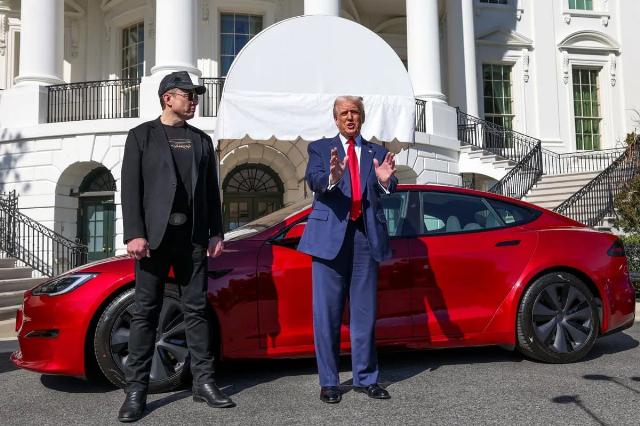
After the conflict with Musk, Trump wanted to sell or give someone a Tesla, which he bought in March 2025. The move is purely symbolic, as Trump has not driven himself for many years / © NBC
But there are also problems that cannot really be solved when contracts with SpaceX are terminated. It's about the Moon: The Artemis program, launched by Trump in his first term, requires a lander. So far, Starship is slated for his role. This is impossible without a contract. And without Starship, the United States will not land on Selena in the 2020s by any means, under any strain, under any assumptions. It is impossible to sit down later: China has stated that it will do so "by 2030." The American mentality does not accept second place, which is why this option is unacceptable.
Of course, theoretically, the lunar lander was ordered by Blue Origin. However, Musk is not the chief engineer of this private space company. That's why its success is incomparably less than that of SpaceX. Its module will not be ready in the 2020s. Any other space players in the United States or the world (except the Chinese) have even less chance of achieving such achievements than Blue Origin.
Finally, there is a third, more distant problem. As we have already noted, in the launch window of 2028-2029, Elon Musk will almost certainly launch five unmanned Starships to Mars at once, which will try to land there. The graph above clearly shows that by this point his income from space will exceed the NASA budget, so he clearly has enough funds for this campaign.
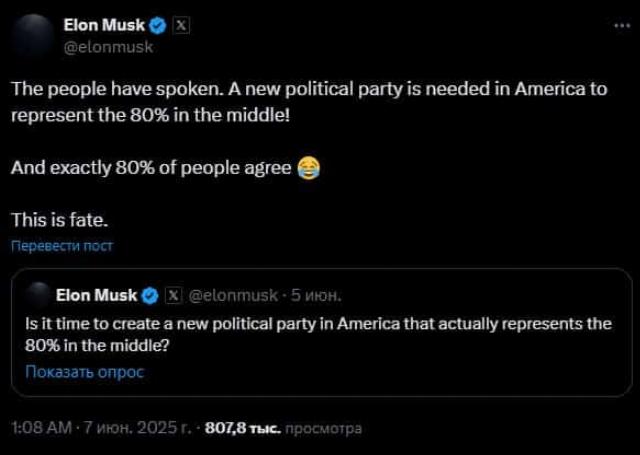
Apparently, in order to fan the flames of conflict to the skies, Musk conducted a survey in X, which involved 5.6 million confirmed users. The vast majority of them expectedly voted for the creation of a new political party in America, which the head of SpaceX designated as centrist. It's not hard to guess who Elon sees as its organizer and inspiration / © X, I.Musk
If at least one of them succeeds in this, and it is quite possible, the event will become a huge milestone in the history of terrestrial cosmonautics and will have a stunning PR effect. Recall that so far, only one country, the United States, has managed to land something gently and without problems on the surface of Mars. And even their heaviest "paratrooper" weighed less than a ton. Landing a spacecraft of hundreds of tons, with a serious payload, will be a qualitative breakthrough. And this landing is also part of the tests before sending people to the fourth planet.
Trump will still be president at this moment. If he broke his contracts with SpaceX now, its success would be his defeat. He will save it, and it will become his major PR victory. Which he really needs: modern America, from his point of view, is seriously sick in the head. It takes more than one term of Republican presidents to cure it. In such circumstances, it's just stupid to deprive yourself of great success. And giving it to someone you've publicly stripped of their contracts is even stupider.
The best scenario — that is, a sincere reconciliation between Musk and Trump and the normal development of space programs — we will not even discuss. Given the personalities of these people, he is, frankly, not very simple. Let's go straight to scenario number 3.
The most likely development of events
A careful reading of Trump's posts shows that he has not directly announced the withdrawal of contracts with SpaceX. Today, after sitting down and thinking over the above again, he will surely find a way to pretend that nothing super-bad has happened. Yes, Elon is wrong, he will say, well, now. We will conduct a complete reassessment of existing government contracts with Musk and subsidies for his companies.
No matter how you overestimate it, there is no one else to fly into space from the USA. So the contracts won't be broken. This means that the United States will continue to fly to the ISS on its own, land on the Moon no later than 2028, and in 2029, under their auspices — and not his own — Musk will try to land five ships on Mars.
The problem is that Trump and Musk are not the only inhabitants of the American political sandbox. Besides them, there is another category of living beings: professional congressional politicians.
And they had already, even before yesterday's conflict between the president and the businessman, tried to hammer wedges between them in space policy. Infamous lobbyist Senator Ted Cruz proposed giving another $10 billion to the notoriously dead-end projects of the SLS rocket and the Orion spacecraft, as well as the Lunar Gateway station. One SLS + Orion launch costs $4.1 billion, meaning this support is only enough for a couple of launches. But Cruz doesn't need much: he's not interested in them, but in money. The money for these rockets goes to "his" staff and to those businesses that sponsor his election campaign. Everything else is unimportant. Actually, this is why the SLS (Space Launch System) rocket has been jokingly interpreted by the US population as the Senate Launch System for many years.
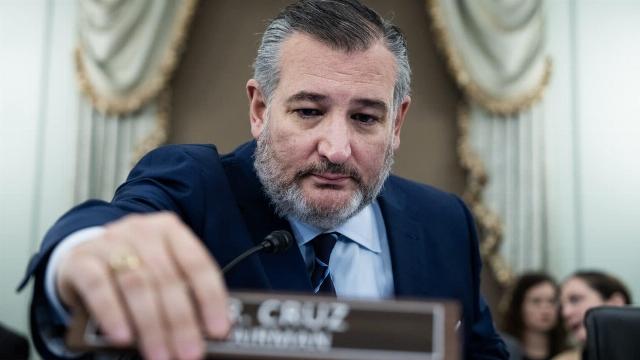
Senator Ted Cruz of Texas chairs the Senate Committee on Commerce, Science and Transportation, which oversees all space activities / © Tom Williams, CQ Roll Call
Yes, the circumlunar station will not be able to be permanently inhabited, like the ISS, because there cosmic radiation is twice as high as on the surface of the Moon (fortunately, the Moon under people's feet intercepts half of the radiation coming from the lower hemisphere). Yes, it is not needed at all, because its habitable volume is smaller than that of Starship, besides it is divided into small chambers. And Starship will be a lunar lander anyway, which is why the need for a separate lunar station is, to put it mildly, not obvious. But Cruz doesn't care: he doesn't have to go to the station. But the money that the state will spend on it directly affects its interests.
Another interesting detail: the Senate committee in charge of space, where Cruz is in charge, has already come up with the idea of imposing "fees for the FAA" on American space companies. Under the pretext that the US Federal Aviation Administration is wasting time on obtaining permits for space flights, Congress is proposing to impose a levy on cargo launched into space from the United States. The figures don't look like much: $1.5 per pound being launched into space, and $200,000 per cargo being returned from space.
The problem is that almost all of these duties will be paid by exactly one company, SpaceX. Recall that it launches more than 80 percent of the world's cargo. But the output tonnage is growing rapidly. The already outlined plans for Starship launches in the 2030s are a thousand ships to Mars per year. With a load of 200 tons, this is a "modest" half a million dollars for each launch or half a billion dollars per year for a thousand launches. And if fuel for refueling ships in orbit is also taxed as a payload (which is quite possible legally), then Musk will pay at least four billion dollars a year (each Starship requires more than one and a half thousand tons of fuel).
Each return after the refueling tanker's flight into orbit can be interpreted as a "cargo return from space." Simply because the tanker requires a small amount of fuel to land safely, which was its cargo while it was carrying it into orbit. It takes at least ten thousand tanker flights to launch a thousand Starships to Mars. In other words, Congress wants to raise two billion more here. At least six in total.
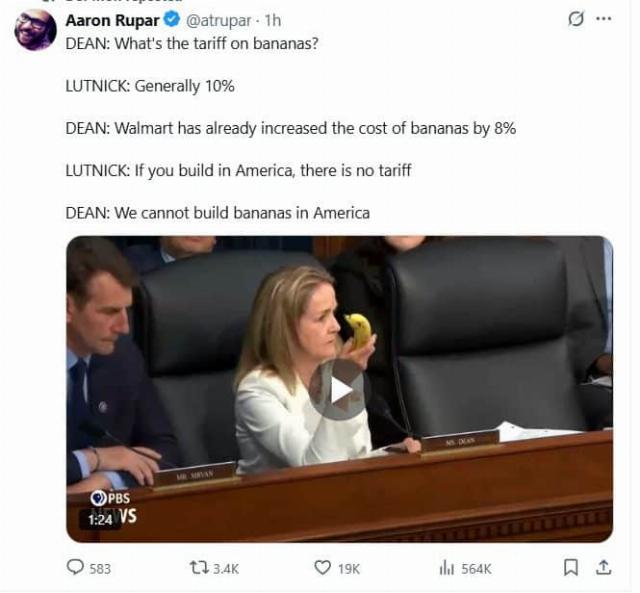
Republicans on Trump's side in Congress have generally managed to show themselves to be extraordinary figures who do not always fully take into account the peculiarities of the reality surrounding them. The idea of growing bananas in America is not even the brightest of their achievements. To be fair, the Democratic Congressmen are no better / © X, Aaron Ruper
The rest of the American companies will pay almost nothing, because their share in US payload launches, already minuscule today, due to Musk's existence, will fall below one percent in the 2030s.
Cruz and professionals like him in eating up budget money cannot miss such an opportunity as the conflict of the "girls". They will definitely come to Trump with theses: you see how unreliable this Mask is. We need to be safe. To finance our esteemed and very experienced friends from Boeing and Lockheed Martin. Yes, they need four billion dollars each to launch, and Musk needs tens of millions today and a few millions tomorrow. But does it really matter? As you can see, he deviates from the party line.
If Trump goes along with them, the American manned space program will turn into a clowning. Because by the early 2030s, NASA will be flying to the expensive lunar station on expensive SLS+ Orion, spending tens of billions of dollars a year, and that's about it. Meanwhile, SpaceX will start flying to Mars on its own, because Cruz and his associates will not be able to give it government contracts for the delivery of astronauts to Mars because of their too strong selfless love for budget money. By that time, Trump will no longer be in power and will be able to influence little.
Instead of excellent PR, landing on the fourth planet will become an unpleasant stain on the reputation of the American state. It will act not as the arbiter of human history, but as a petty corrupt official trying to prevent those who will land people in another world for the first time.
While they're fighting there, our forelocks are cracking: what will this whole story mean for Russia
As we have already noted, the development of Russian civil cosmonautics today is 90 percent determined by the development of the American one. Let's recall the history of Amur-LNG: at its very beginning, 12 years ago, we thought of it as a completely disposable rocket with two side blocks. In this text, we have separately described why side blocks are a technically poor, expensive solution. And after the success of the Falcon 9 in the second half of the 2010s, the project had mentions of using the first stage repeatedly, just like the SpaceX rocket.
It took our space industry five years (2020) to react to the success and adjust its plans for it. It will take another 9-10 years to bring this to mass-produced flying hardware (counting down from 2020). From this we can conclude: about five years after the start of Starship flights, we will have a project for a similar carrier with two reusable stages. And another 10-12 years later, a flying rocket of this kind.
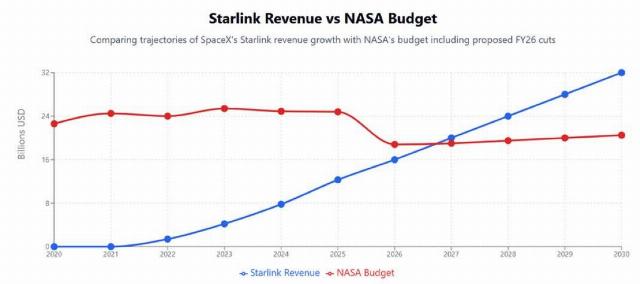
The chart of Starlink's revenue and NASA's revenue shows that Musk has such sources of financing for his space flights that in the near future will seriously exceed the budgets of the government agency from which Trump wants to excommunicate him / © Wikimedia Commons
Therefore, the termination of contracts or the slowdown of work on Starship is highly undesirable for us. If Musk starts mass-launching them in 2027, the most likely scenario before his conflict with Trump, then we will see a domestic rocket of this type in the first half of the 2040s. If the Trump administration goes along with Cruz and decides to put sticks in the wheels of SpaceX so that it does not overtake respected business partners, respected senators and congressmen, the situation could get much worse. The former democratic administration of the United States has already delayed administrative issues during the Starship trials. It is difficult to rule out similar delays from the new administration.
And with them, regular Starship flights may even not start later (because in this case, Trump may lose the moon race to China), but go at a much slower pace. Musk simply won't approve his requests for hundreds and thousands of Starship flights a year, for example, citing noise for ordinary Texans or environmental damage to whales from falling rockets, which has already surfaced in FAA requests to SpaceX under Biden.
Of course, Starlink does not have any shares, because SpaceX, which controls it, is a private company, not a joint-stock company. Musk's reaction (laughter to tears) to this post is also easy to understand. But the fact is that serious conflicts between these two guys are really not in the interests of Russia. In particular, its space industry / © X, D.A. Medvedev, I. Musk
Hopefully, Trump won't go that far in his clash with the migrant businessman. Indeed, if Musk is allowed only 10-12 launches per year, he will be able to take people to the Moon as part of the Artemis program, but will not send five ships to Mars in 2028-2029. After all, each such ship will require 10-15 refueling by Starship tankers.
But the PR effect of sticking sticks in the wheels will be disastrous. Personal revenge in such a case can bury not only Trump's rating, but also the chances of his vice president Vance becoming the next head of the United States. If the White House realizes this in time, there is no need to worry about the future of Russian space.
Alexander Berezin
